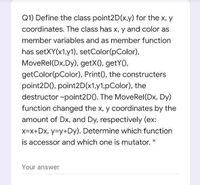
Database System Concepts
7th Edition
ISBN: 9780078022159
Author: Abraham Silberschatz Professor, Henry F. Korth, S. Sudarshan
Publisher: McGraw-Hill Education
expand_more
expand_more
format_list_bulleted
Concept explainers
Question
Please solve quickly OOP

Transcribed Image Text:Q1) Define the class point2D(x.y) for the x, y
coordinates. The class has x, y and color as
member variables and as member function
has setXY(x1,y1), setColor(pColor),
MoveRel(Dx,Dy), getX(), getY(),
getColor(pColor), Print(), the constructers
point2D(), point2D(x1,y1,pColor), the
destructor ~point2D(). The MoveRel(Dx, Dy)
function changed the x, y coordinates by the
amount of Dx, and Dy, respectively (ex:
x=x+Dx, y=Dy+Dy). Determine which function
is accessor and which one is mutator.
Your answer
Expert Solution
This question has been solved!
Explore an expertly crafted, step-by-step solution for a thorough understanding of key concepts.
Step by stepSolved in 4 steps with 1 images

Knowledge Booster
Learn more about
Need a deep-dive on the concept behind this application? Look no further. Learn more about this topic, computer-science and related others by exploring similar questions and additional content below.Similar questions
- Write a solution algorithm to find the mean ages of students in a class using a method pseudocodearrow_forwardDevise a recursive algorithm for finding n! mod m where n and m are positive integers.arrow_forwardWhich of the following is correct to Greedy Algorithm? a. It solves a problem by breaking down a problem into "non-overlapping" sub-problems. O b. It solves a problem by trying all possible options. O c. It solves a problem by getting the best option of each step during operations. O d. It solves a problem by breaking down a problem into "overlapping" sub-problems.arrow_forward
- Question 5 Please answer them correctly by choosing one of the following answerarrow_forwardCan you post the code to solve these?arrow_forwardPlease solve max 30 minutes thank u Boolean Satisfaction Problem Boolean Satisfiability Problem (SAT) (https://en.wikipedia.org/wiki/Boolean_satisfiability_problem) is one of the most important problems in Computer Science. SAT is a problem that has NP-Complete complexity, where the only way to solve the problem is to try all the possibilities and check which one is correct. [LO 1, LO 2, LO 3 & LO 4,] Briefly explain how you use Strongly Connected Component (SCC) to solve the special case of the Boolean Satisfiability Problem, namely 2-SAT (https://en.wikipedia. org/wiki/2-SAT) . This solution has linear complexity. NOTE LO1: Explain fundamental concept of analysis arithms. LO2: Apply algorithm techniques and methods. LO3: Solve a problem using specific algorithm. LO4: Compare several algorithm design methodsarrow_forward
arrow_back_ios
arrow_forward_ios
Recommended textbooks for you
 Database System ConceptsComputer ScienceISBN:9780078022159Author:Abraham Silberschatz Professor, Henry F. Korth, S. SudarshanPublisher:McGraw-Hill Education
Database System ConceptsComputer ScienceISBN:9780078022159Author:Abraham Silberschatz Professor, Henry F. Korth, S. SudarshanPublisher:McGraw-Hill Education Starting Out with Python (4th Edition)Computer ScienceISBN:9780134444321Author:Tony GaddisPublisher:PEARSON
Starting Out with Python (4th Edition)Computer ScienceISBN:9780134444321Author:Tony GaddisPublisher:PEARSON Digital Fundamentals (11th Edition)Computer ScienceISBN:9780132737968Author:Thomas L. FloydPublisher:PEARSON
Digital Fundamentals (11th Edition)Computer ScienceISBN:9780132737968Author:Thomas L. FloydPublisher:PEARSON C How to Program (8th Edition)Computer ScienceISBN:9780133976892Author:Paul J. Deitel, Harvey DeitelPublisher:PEARSON
C How to Program (8th Edition)Computer ScienceISBN:9780133976892Author:Paul J. Deitel, Harvey DeitelPublisher:PEARSON Database Systems: Design, Implementation, & Manag...Computer ScienceISBN:9781337627900Author:Carlos Coronel, Steven MorrisPublisher:Cengage Learning
Database Systems: Design, Implementation, & Manag...Computer ScienceISBN:9781337627900Author:Carlos Coronel, Steven MorrisPublisher:Cengage Learning Programmable Logic ControllersComputer ScienceISBN:9780073373843Author:Frank D. PetruzellaPublisher:McGraw-Hill Education
Programmable Logic ControllersComputer ScienceISBN:9780073373843Author:Frank D. PetruzellaPublisher:McGraw-Hill Education

Database System Concepts
Computer Science
ISBN:9780078022159
Author:Abraham Silberschatz Professor, Henry F. Korth, S. Sudarshan
Publisher:McGraw-Hill Education

Starting Out with Python (4th Edition)
Computer Science
ISBN:9780134444321
Author:Tony Gaddis
Publisher:PEARSON

Digital Fundamentals (11th Edition)
Computer Science
ISBN:9780132737968
Author:Thomas L. Floyd
Publisher:PEARSON

C How to Program (8th Edition)
Computer Science
ISBN:9780133976892
Author:Paul J. Deitel, Harvey Deitel
Publisher:PEARSON

Database Systems: Design, Implementation, & Manag...
Computer Science
ISBN:9781337627900
Author:Carlos Coronel, Steven Morris
Publisher:Cengage Learning

Programmable Logic Controllers
Computer Science
ISBN:9780073373843
Author:Frank D. Petruzella
Publisher:McGraw-Hill Education